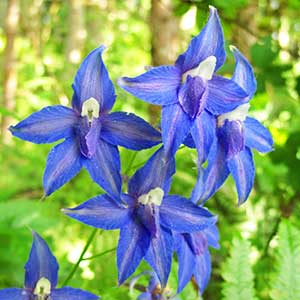Delphinium trolliifolium
Delphinium bicolor
Columbian larkspur, cow-poison, poison delphinium, poison larkspur
Flathead larkspur, little larkspur, low larkspur, Montana larkspur
(40-)60-120(-180) cm;
base usually reddish, glabrous to puberulent.
10-40(-70) cm;
base often reddish, glabrous to puberulent.
blade ± pentagonal, 4-8 × 7-16 cm, margins ± incised, nearly glabrous; ultimate lobes 0-9, width 15-30 mm (basal), 5-20 mm (cauline), widest at middle or in proximal 1/2.
blade round, 1-4 × 1.5-7 cm, glabrous to puberulent; ultimate lobes 3-19, width 1-8 mm (basal), 1-3 mm (cauline).
(5-)14-40(-75)-flowered, ± open, at least 2 times longer than wide;
pedicel 1-4(-9) cm, puberulent to glabrous;
bracteoles (2-)6-12 mm from flowers, green, linear, 5-9(-14) mm, puberulent.
3-12(-22)-flowered;
pedicel 1-4(-8) cm, ± puberulent;
bracteoles 2-7(-17) mm from flowers, green, sometimes white-margined, lanceolate, 4-6(-8) mm, puberulent.
sepals dark blue, glabrous, lateral sepals spreading, (8-)14-21 × 5-9 mm, spurs straight or downcurved at apex, within 20° of horizontal, (10-)16-23 mm;
lower petal blades covering stamens, 5-10 mm, clefts 1.5-3 mm;
hairs sparse, mostly near junction of blade and claw, centered or on inner lobes, well dispersed, yellow.
sepals dark blue, puberulent, lateral sepals usually spreading, 16-21 × 6-12 mm, spurs straight to gently decurved, ascending 0-40° above horizontal, 13-23 mm;
lower petal blades covering stamens, 7-12 mm, clefts 0.1-3 mm;
hairs sparse, short, mostly on inner lobes below junction of blade and claw, white or yellow.
(15-)23-34 mm, 3.8-5.5 times longer than wide, glabrous.
(12-)16-22 mm, 4-4.5 times longer than wide, usually puberulent.
unwinged;
seed coats smooth.
often winged;
seed coat cells with surfaces ± smooth.
= 16.
Delphinium trolliifolium
Delphinium bicolor
Delphinium trolliifolium occurs in the northern Coast Range of California, the Columbia River Valley to just east of Mt. Hood, and the Willamette Valley of Oregon upstream to Lane County. California plants differ somewhat from Oregon plants in pubescence patterns and habitat preferences. Further study may show that two entities are involved here.
Hybrids between Delphinium trolliifolium and D. decorum, D. menziesii subsp. pallidum (D. ×pavonaceum Ewan, Peacock larkspur), D. nudicaule, D. nuttallianum, and D. nuttallii are known. Delphinium trolliifolium is likely to be confused only with D. bakeri. Refer to discussion under that species for differences.
(Discussion copyrighted by Flora of North America; reprinted with permission.)
Subspecies 2 (2 in the flora).
Delphinium bicolor is closely related to D. glareosum; it differs in its wider-lobed cauline leaves, shallower petal clefts, and narrower fruits.
The Gosiute consider this plant to be poisonous (D. E. Moerman 1986, subspecies not specified).
(Discussion copyrighted by Flora of North America; reprinted with permission.)
1. Sepals (especially in fresh material) dark blue to purple; cleft in lower petals 2 mm or less; soils not derived from limestone. | subsp. bicolor |
1. Sepals (especially in fresh material) bright dark blue; cleft in lower petals at least 2 mm; soils derived from limestone. | subsp. calcicola |


